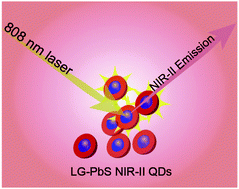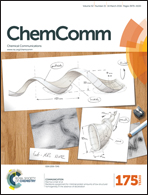Direct water-phase synthesis of lead sulfide quantum dots encapsulated by β-lactoglobulin for in vivo second near infrared window imaging with reduced toxicity†
Abstract
Compared to conventional fluorescence imaging in the visible (400–700 nm) and NIR-I regions (700–900 nm), optical fluorescence imaging in the second near infrared window (NIR-II, 1000–1400 nm) offers reduced photon scattering, deeper tissue penetration and lower auto-fluorescence. Despite excellent imaging capabilities, current NIR-II probes have not yet reached their full potential due to weak quantum yield, low water solubility and suboptimal biocompatibility. To address these problems, we report herein a new NIR-II fluorescent PbS quantum dots (QDs) that are fabricated in water using β-lactoglobulin (LG) as a biological template. The LG-PbS QDs exhibit satisfactory dispersibility, relatively high quantum yield and favorable biocompatibility, and therefore are suitable for high-resolution in vivo imaging applications.


 Please wait while we load your content...
Please wait while we load your content...